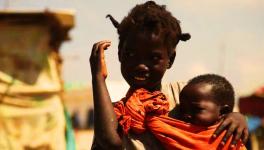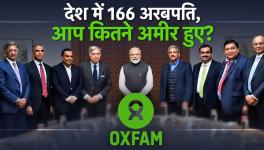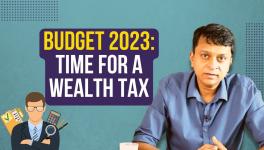Rich Got Richer: Covid-19 Spiked Wealth, Gender, Educational, and Health Inequalities
During the Covid-19 pandemic, for the first time, inequality rose across the world at the same time, finds a new Oxfam report. The dire situations during the pandemic, with lockdowns and job losses, have aggravated a world that was already extremely unequal.
The pandemic has widened the existing social, economic and gender-based inequalities worldwide. The Oxfam report The Inequality Virus, in its global issue, said that it took just nine months for the fortunes of the world’s top 1,000 billionaires to return to their pre-pandemic highs. However, for the world’s poorest people, the recovery could take more than a decade. It added that the increase in the 10 richest billionaires’ wealth since the pandemic began, is more than enough “to prevent anyone on Earth from falling into poverty because of the virus, and to pay for a COVID-19 vaccine for everyone.”
The situation in India regarding wealth inequality is similar. The wealth of Indian billionaires increased by 35% during the lockdown while unemployment, hunger, distress migration and other hardship hit the poor and the country’s economy dipped
into recession for the first time after a quarter of a Century. At the same time, the Indian billionaires put India at the sixth position in the world after US, China, Germany, Russia and France, states the India supplement of The Inequality Virus report.
India’s Wealth Inequality:
To give a more fathomable idea, the report estimates that India’s 100 billionaires have seen their fortunes increase by Rs 12,97,822 crores since March 2020--which is enough to give Rs 94,045 to each of the 138 million poorest Indians.
In another estimate, the report showed that it would take an unskilled worker 10,000 years to make what Mukesh Ambani made in an hour during the pandemic. Ambani’s wealth rose to Rs 5837 billion with an increase of 72%, making him world’s fourth richest man and the richest man in India and Asia.
Meanwhile, “the government was reluctant to spend on public welfare but the corporate sector and India’s elites were actively subsidized by the government,” the report said. It also cited media reports that showed how the fourth tranche of the government’s Covid-19 relief package benefitted big corporates like the Adani Group, Reliance Group and Vedanta, among others. “The provision of interest-free loans to Medium and Small Enterprises alone is calculated to have been worth INR 3 lakh crore, almost ten times the quantum of funds directly given to the poor (including Jan Dhan, PM Kisan Yojana and transfers to old persons, widows, disabled and construction workers),” the report said.
Informal workers have been worst hit by the economic slowdown. Out of a total 122 million who lost their jobs, 92 million jobs (75%) were lost in the informal sector. Over 300 informal workers also died due to the lockdown, “with reasons ranging from starvation, suicides, exhaustion, road and rail accidents, police brutality and denial of timely medical care,” according to the report.
As a result, India saw its biggest migration since Independence with about 10.6 million people walking thousands of kilometres to return to their villages, with many dying along the way.
The report further sheds light on the pandemic’s impact on health, livelihood and access to education, which has hit the country’s women, poor and the marginalised groups the most.
Gendered Impact of Covid
The report estimates that 17 million women lost their jobs in April 2020 as the sectors hardest-hit by the pandemic had over-representation of women. Women’s unemployment also rose by 15% compared to pre-lockdown levels. “This increase in unemployment of women can result in a loss to India’s GDP of about 8% or USD 218 billion,” the report states.
Meanwhile, in this period, the total time spent in both paid and unpaid activities by women has risen with the increase in the household chores and care-giving work as they stayed homes. “The work-from-home culture has also blurred the lines between working hours and personal downtime,” the report says.
In a disturbing development, domestic violence against women also increased during the pandemic. The National Commission for Women received 1477 complaints of domestic violence from women between March 25 and May 31, 2020, alone.
“Economic hardships and growing anxiety during emergencies often fuel violent and abusive relationships directed towards women and the pandemic has been no exception. This has unfortunately led to an increase in cases of domestic violence,” the report said.
Educational Inequalities:
The pandemic has led to the closure of schools, colleges and other educational institutes since March 2020. This has impacted students from marginalised section the most since the school system is heavily used to deliver social welfare in India.
Till the end of October 2020, over 32 crores students were affected by the closure of educational institutions and of these, 84% of students reside in rural areas and 70% attend government schools.
Further, more than 60 lakh Scheduled Caste and Scheduled Tribe students enrolled in higher secondary education who get 100% and 75% centrally funded scholarships respectively, have not received those.The closure of government schools has disrupted the mid-day meal scheme that covers 120 million children in 1.26 million schools. This poses the risk of malnutrition among vulnerable communities, especially Dalits and Adivasis, the report states.
“Oxfam India’s survey has found that despite being asked by the Supreme Court to continue the scheme, 35 percent children did not receive their mid-day meals,” the report says.
As education shifted online during the pandemic, India saw the digital divide between socio-economic classes worsening as just 3% of the poorest 20% of Indian households had access to a computer and only 9% had access to the internet.
Health Inequalities:
Isolation and social distancing was not an available option for the poor during the pandemic. The report notes,“...The spread of disease was swift among poor communities, often living in crammed areas with poor sanitation and using shared common facilities such as toilets and water points.”
Only a minuscule 6% of the poorest 20% population has access to non-shared sources of improved sanitation, compared to 93.4% of the top 20% of the population, the report estimated. Moreover, 59.6% of the country’s population lives in a single room or less.
“Pregnant women belonging to poor families were often left unassisted as most public health care institutions were turned into COVID-19 testing facilities and hospitals. The urgent need for healthcare resulted in massive profiteering from many private health establishments and while the government did take steps to make COVID-19 services affordable by including them under Ayushman Bharat-PMJAY, the scheme only covered BPL population leaving out the uninsured poor and the Middle Class,” the report states.
It’s important to note that India has the world’s fourth-lowest health budget in terms of its share of government expenditure, and people pay for more than 70% of health expenses themselves. Only half the country’s population has access to even the most basic healthcare services, the unequal reality that was aggravated during the health crisis triggered by the pandemic.
What’s The Way Ahead:
As India’s poor and vulnerable communities were reeling from the harsh blows of the pandemic, the country’s initial relief package allocated only 0.8% of GDP to social protection for families. The health budgetary allocation should urgently be increased to 2.5% of the GDP to boost the public health system and reduce out of pocket expenditure, Oxfam India CEO Amitabh Behar said in a statement.
He suggested that the Covid-19 crisis must be a turning point in how India taxes its richest individuals and big corporations. “Progressive taxation of the richest members of the society must be the cornerstone of any equitable recovery from the crisis,” Behar added.
“Newer and creative ways of catering to the needs of the masses is possible if governments are committed to the needs of its people. It is time for the Government of India to take specific and concrete actions that will build a better future. We can build a future that is led by citizens’ voices who seek a more equal and just future,” Behar said.
Get the latest reports & analysis with people's perspective on Protests, movements & deep analytical videos, discussions of the current affairs in your Telegram app. Subscribe to NewsClick's Telegram channel & get Real-Time updates on stories, as they get published on our website.
























